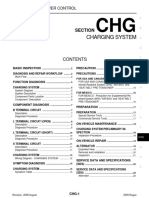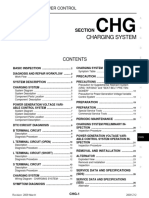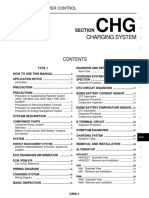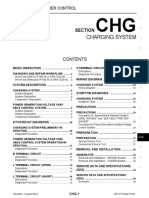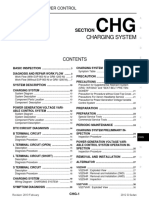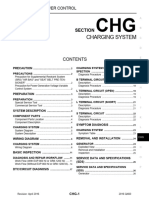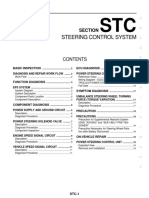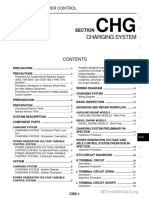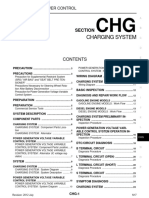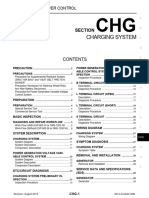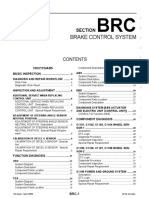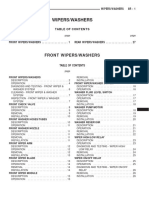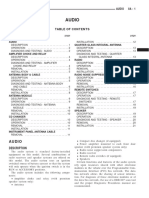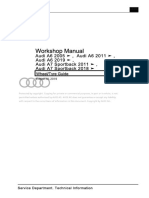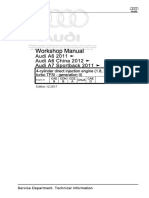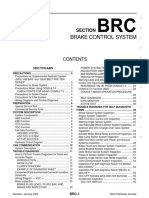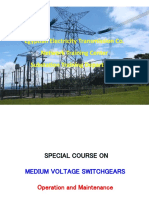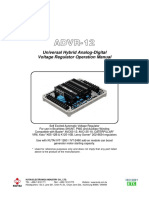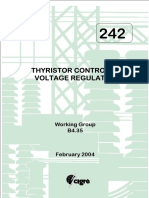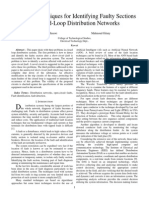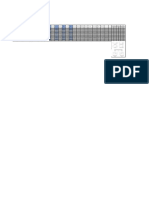Professional Documents
Culture Documents
Charging System: Section
Charging System: Section
Uploaded by
Ruhu royOriginal Description:
Original Title
Copyright
Available Formats
Share this document
Did you find this document useful?
Is this content inappropriate?
Report this DocumentCopyright:
Available Formats
Charging System: Section
Charging System: Section
Uploaded by
Ruhu royCopyright:
Available Formats
ELECTRICAL & POWER CONTROL
SECTION CHG
CHARGING SYSTEM
B
E
CONTENTS
BASIC INSPECTION .................................... 3 CHARGING SYSTEM ....................................... 19 F
Symptom Table .......................................................19
DIAGNOSIS AND REPAIR WORKFLOW .......... 3
Work Flow ................................................................. 3 PRECAUTION .............................................. 20 G
SYSTEM DESCRIPTION .............................. 6 PRECAUTIONS ................................................. 20
Precaution for Supplemental Restraint System
CHARGING SYSTEM .......................................... 6 (SRS) "AIR BAG" and "SEAT BELT PRE-TEN- H
System Diagram ........................................................ 6 SIONER" .................................................................20
System Description ................................................... 6 Service Procedure Precautions for Models with a
Component Parts Location ........................................ 6 Pop-up Roll Bar .......................................................20 I
Component Description ............................................ 7 Precaution for Power Generation Voltage Variable
Control System ........................................................20
POWER GENERATION VOLTAGE VARI- Precaution for Battery Service .................................20
ABLE CONTROL SYSTEM ................................. 8 J
System Diagram ........................................................ 8 PREPARATION ........................................... 22
System Description ................................................... 8
Component Parts Location ........................................ 8 PREPARATION ................................................. 22 K
Component Description ............................................. 9 Special Service Tools ..............................................22
Commercial Service Tools .......................................22
DTC/CIRCUIT DIAGNOSIS ......................... 10
PERIODIC MAINTENANCE ........................ 23 L
B TERMINAL CIRCUIT ......................................10
Description .............................................................. 10 CHARGING SYSTEM PRELIMINARY IN-
Diagnosis Procedure ............................................... 10 SPECTION ........................................................ 23 CHG
Inspection Procedure ...............................................23
L TERMINAL CIRCUIT (OPEN) .........................11
Description .............................................................. 11 POWER GENERATION VOLTAGE VARI-
Diagnosis Procedure ............................................... 11 ABLE CONTROL SYSTEM OPERATION IN- N
SPECTION ........................................................ 24
L TERMINAL CIRCUIT (SHORT) .......................13 Inspection Procedure ...............................................24
Description .............................................................. 13 O
Diagnosis Procedure ............................................... 13 REMOVAL AND INSTALLATION ............... 26
S TERMINAL CIRCUIT ......................................14 ALTERNATOR .................................................. 26
Description .............................................................. 14 Exploded View .........................................................26 P
Diagnosis Procedure ............................................... 14 Removal and Installation .........................................27
Inspection ................................................................28
CHARGING SYSTEM .........................................15
Wiring Diagram - CHARGING SYSTEM - ............... 15 SERVICE DATA AND SPECIFICATIONS
SYMPTOM DIAGNOSIS .............................. 19 (SDS) ............................................................ 29
Revision: 2010 March CHG-1 2009 G37 Convertible
SERVICE DATA AND SPECIFICATIONS Alternator ................................................................ 29
(SDS) .................................................................. 29
Revision: 2010 March CHG-2 2009 G37 Convertible
DIAGNOSIS AND REPAIR WORKFLOW
< BASIC INSPECTION >
BASIC INSPECTION A
DIAGNOSIS AND REPAIR WORKFLOW
Work Flow INFOID:0000000004804434
B
OVEROALL SEQUENCE
C
CHG
JSMIA0009GB
DETAILED FLOW
Revision: 2010 March CHG-3 2009 G37 Convertible
DIAGNOSIS AND REPAIR WORKFLOW
< BASIC INSPECTION >
NOTE:
To ensure a complete and thorough diagnosis, the battery, starter and alternator test segments must be done
as a set from start to finish.
1.PRELIMINARY INSPECTION
Perform the preliminary inspection. Refer to CHG-23, "Inspection Procedure".
>> GO TO 2.
2.STOP POWER GENERATION VOLTAGE VARIABLE CONTROL SYSTEM
Stop the operation of the power generation voltage variable control in either of the following procedures.
• After selecting “ENGINE” of “SELECT SYSTEM” using CONSULT-III, set the DUTY value of “ALTERNATOR
DUTY” to 0 % by selecting “ALTERNATOR DUTY” of “Active Test”. Continue “Active Test” until the end of
inspection. (When the DUTY value is 0 or 100 %, the normal power generation is performed according to the
characteristic of the IC voltage regulator of the alternator.)
• Turn the ignition switch OFF, and disconnect the battery current sensor connector. [However, DTC (P1550 -
P1554) of the engine might remain. After finishing the inspection, connect the battery current sensor connec-
tor and erase the self-diagnostic results history of the engine using CONSULT-III.]
>> GO TO 3.
3.DIAGNOSIS WITH STARTING/CHARGING SYSTEM TESTER
Perform the charging system test using Starting/Charging System Tester (SST: J-44373). For details and oper-
ating instructions, refer to Technical Service Bulletin.
Test result
CHARGING SYSTEM NOMAL>>Charging system is normal and will also show “DIODE RIPPLE” test result.
NO CHARGING VOLTAGE>>GO TO 4.
LOW CHARGING VOLTAGE>>GO TO 12.
HIGH CHARGING VOLTAGE>>GO TO 14.
DIODE RIPPLE NORMAL>>Diode ripple is OK and will also show “CHARGING VOLTAGE” test result.
EXCESS RIPPLE DETECTED>>Replace the alternator. Perform “DIODE RIPPLE” test again using Starting/
Charging System Tester (SST: J-44373) to confirm repair.
DIODE RIPPLE NOT DETECTED>>GO TO 4.
4.INSPECTION WITH CHARGE WARNING LAMP (IGNITION SWITCH IS ON)
Turn the ignition switch ON.
Does the charge warning lamp illuminate?
YES >> GO TO 6.
NO >> GO TO 5.
5.“L” TERMINAL CIRCUIT (OPEN) INSPECTION
Check “L” terminal circuit (open). Refer to CHG-11, "Diagnosis Procedure".
Is the “L” terminal circuit normal?
YES >> Replace alternator.
NO >> Repair as needed.
6.INSPECTION WITH CHARGE WARNING LAMP (IDLING)
Start the engine and run it at idle.
Does the charge warning lamp turn OFF?
YES >> GO TO 9.
NO >> GO TO 7.
7.“L” TERMINAL CIRCUIT (SHORT) INSPECTION
Check “L” terminal circuit (short). Refer to CHG-13, "Diagnosis Procedure".
Is the “L” terminal circuit normal?
YES >> GO TO 8.
NO >> Repair as needed.
Revision: 2010 March CHG-4 2009 G37 Convertible
DIAGNOSIS AND REPAIR WORKFLOW
< BASIC INSPECTION >
8.“S” TERMINAL CIRCUIT INSPECTION A
Check “S” terminal circuit. Refer to CHG-14, "Diagnosis Procedure".
Is the “S” terminal circuit normal?
YES >> GO TO 10. B
NO >> Repair as needed.
9.INSPECTION WITH CHARGE WARNING LAMP (ENGINE AT 3,000 RPM)
C
Increase and maintain the engine speed at 3,000 rpm.
Does the charge warning lamp remain off?
YES >> GO TO 11. D
NO >> GO TO 10.
10.INSPECTION OF ALTERNATOR PULLEY
Check alternator pulley. Refer to CHG-28, "Inspection". E
Is alternator pulley normal?
YES >> Replace alternator.
NO >> Repair as needed. F
11.“B” TERMINAL CIRCUIT INSPECTION
Check “B” terminal circuit. Refer to CHG-10, "Diagnosis Procedure". G
Is “B” terminal circuit normal?
YES >> Replace alternator.
NO >> Repair as needed. H
12.“B” TERMINAL CIRCUIT INSPECTION
Check “B” terminal circuit. Refer to CHG-10, "Diagnosis Procedure".
I
Is “B” terminal circuit normal?
YES >> GO TO 13.
NO >> Repair as needed.
J
13.INSPECTION OF ALTERNATOR PULLEY
Check alternator pulley. Refer to CHG-28, "Inspection".
Is alternator pulley normal? K
YES >> Replace alternator.
NO >> Repair as needed.
14.“S” TERMINAL CIRCUIT INSPECTION L
Check “S” terminal circuit. Refer to CHG-14, "Diagnosis Procedure".
Is the “S” terminal circuit normal? CHG
YES >> Replace alternator.
NO >> Repair as needed.
N
Revision: 2010 March CHG-5 2009 G37 Convertible
CHARGING SYSTEM
< SYSTEM DESCRIPTION >
SYSTEM DESCRIPTION
CHARGING SYSTEM
System Diagram INFOID:0000000004804435
JPMIA0633GB
System Description INFOID:0000000004804436
The alternator provides DC voltage to operate the vehicle's electrical system and to keep the battery charged.
The voltage output is controlled by the IC voltage regulator.
Component Parts Location INFOID:0000000004804437
JSMIA0010ZZ
1. Battery 2. IPDM E/R 3. Alternator
4. Charge warning lamp
A. Engine room dash panel (RH) B. Engine C. Combination meter
Revision: 2010 March CHG-6 2009 G37 Convertible
CHARGING SYSTEM
< SYSTEM DESCRIPTION >
Component Description INFOID:0000000004804438
Component part Description
“B” terminal Refer to CHG-10, "Description". B
“S” terminal Refer to CHG-14, "Description".
Alternator “L” terminal Refer to CHG-11, "Description".
C
Used for the power generation voltage variable control system.
“C” terminal
Refer to CHG-8, "System Description".
The IC voltage regulator warning function activates to illuminate
the charge warning lamp, if any of the following symptoms occur D
Combination meter (Charge warning lamp) while alternator is operating:
• Excessive voltage is produced.
• No voltage is produced. E
Used for the power generation voltage variable control system.
IPDM E/R
Refer to CHG-8, "System Description".
CHG
Revision: 2010 March CHG-7 2009 G37 Convertible
POWER GENERATION VOLTAGE VARIABLE CONTROL SYSTEM
< SYSTEM DESCRIPTION >
POWER GENERATION VOLTAGE VARIABLE CONTROL SYSTEM
System Diagram INFOID:0000000004804439
JPMIA0632GB
System Description INFOID:0000000004804440
By performing the power generation voltage variable control, the engine load due to the power generation of
the alternator is reduced and fuel consumption is decreased.
NOTE:
When any malfunction is detected in the power generation voltage variable control system, the power genera-
tion is performed according to the characteristic of the IC voltage regulator of the alternator.
Component Parts Location INFOID:0000000004804441
JSMIA0011ZZ
1. Battery 2. IPDM E/R 3. Battery current sensor
4. ECM 5. Alternator
A. Engine room dash panel (RH) B. Behind glove box C. Engine
Revision: 2010 March CHG-8 2009 G37 Convertible
POWER GENERATION VOLTAGE VARIABLE CONTROL SYSTEM
< SYSTEM DESCRIPTION >
Component Description INFOID:0000000004804442
Component part Description
Battery current sensor is installed to the battery cable at the neg- B
ative terminal, and it detects the charging/discharging current of
Battery current sensor
the battery and sends the voltage signal to ECM according to the
current value.
C
Battery current sensor detects the charging/discharging current of
the battery. ECM judges the battery condition based on this signal.
ECM judges whether to perform the power generation voltage
ECM
variable control according to the battery condition. D
When performing the power generation voltage variable control,
ECM calculates the target power generation voltage according to
the battery condition and sends the calculated value as the power
generation command value to IPDM E/R. E
IPDM E/R converts the received power generation command val-
IPDM E/R ue into the power generation command signal (PWM signal) and
sends it to the IC voltage regulator. F
IC voltage regulator controls the power generation voltage by the
target power generation voltage based on the received power gen-
eration command signal.
Alternator (IC voltage regulator) G
When there is no power generation command signal, the alterna-
tor performs the normal power generation according to the char-
acteristic of the IC voltage regulator.
H
CHG
Revision: 2010 March CHG-9 2009 G37 Convertible
B TERMINAL CIRCUIT
< DTC/CIRCUIT DIAGNOSIS >
DTC/CIRCUIT DIAGNOSIS
B TERMINAL CIRCUIT
Description INFOID:0000000004804443
“B” terminal circuit supplies power to charge the battery and to operate the vehicle’s electrical system.
Diagnosis Procedure INFOID:0000000004804444
1.CHECK “B” TERMINAL CONNECTION
1. Turn ignition switch OFF.
2. Check if “B” terminal is clean and tight.
Is the inspection result normal?
YES >> GO TO 2.
NO >> Repair “B” terminal connection. Confirm repair by performing complete Starting/Charging system
test. Refer to Technical Service Bulletin.
2.CHECK “B” TERMINAL CIRCUIT
Check voltage between alternator “B” terminal and ground.
Terminals
(+) Voltage (Approx.)
(–)
Alternator “B” terminal Terminal
E203 1 Ground Battery voltage
Is the inspection result normal?
YES >> GO TO 3.
NO >> Check harness for open between alternator and fusible link.
3.CHECK “B” TERMINAL CONNECTION (VOLTAGE DROP TEST)
1. Start engine, then engine running at idle and warm.
2. Check voltage between battery positive terminal and alternator “B” terminal.
Terminals
(–) Voltage (Approx.)
(+)
Alternator “B” terminal Terminal
Battery positive terminal E203 1 Less than 0.2 V
Is the inspection result normal?
YES >> “B” terminal circuit is normal. Refer to CHG-3, "Work Flow".
NO >> Check harness between battery and alternator for poor continuity.
Revision: 2010 March CHG-10 2009 G37 Convertible
L TERMINAL CIRCUIT (OPEN)
< DTC/CIRCUIT DIAGNOSIS >
L TERMINAL CIRCUIT (OPEN)
A
Description INFOID:0000000004804445
The “L” terminal circuit controls the charge warning lamp. The charge warning lamp illuminates when the igni- B
tion switch is set to ON or START. When the alternator is providing sufficient voltage with the engine running,
the charge warning lamp will go off. If the charge warning lamp illuminates with the engine running, a malfunc-
tion is indicated.
C
Diagnosis Procedure INFOID:0000000004804446
1.CHECK “L” TERMINAL CONNECTION D
1. Turn ignition switch OFF.
2. Check if “L” terminal is clean and tight.
Is the inspection result normal? E
YES >> GO TO 2.
NO >> Repair “L” terminal connection. Confirm repair by performing complete Starting/Charging system
test. Refer to Technical Service Bulletin. F
2.CHECK “L” TERMINAL CIRCUIT (OPEN)
1. Disconnect alternator connector.
2. Apply ground to alternator harness connector terminal. G
3. Check condition of the charge warning lamp with the ignition switch in the ON position.
Condition H
Alternator harness connector Terminal
Ground Ignition switch position Charge warning lamp
F36 2 ON illuminate
I
Does it illuminate?
YES >> “L” terminal circuit is normal. Refer to CHG-3, "Work Flow".
NO >> GO TO 3. J
3.CHECK HARNESS CONTINUITY (OPEN CIRCUIT)
1. Disconnect the battery cable from the negative terminal.
2. Disconnect the combination meter connector. K
3. Check continuity between alternator harness connector and combination meter harness connector.
Alternator harness connector Combination meter harness connector L
Continuity
Connector No. Terminal No. Connector No. Terminal No.
F36 2 M53 6 Existed
CHG
Is the inspection result normal?
YES >> GO TO 4.
NO >> Repair the harness or connector.
N
4.CHECK HARNESS CONTINUITY (OPEN CIRCUIT)
Check continuity between combination meter harness connector and fuse block.
O
Combination meter harness connector Fuse block
Continuity
Connector No. Terminal No. Connector No. Terminal No.
M53 21 M3 12C Existed P
Is the inspection result normal?
YES >> GO TO 5.
NO >> Repair the harness.
5.CHECK POWER SUPPLY CIRCUIT
1. Connect the battery cable to the negative terminal.
Revision: 2010 March CHG-11 2009 G37 Convertible
L TERMINAL CIRCUIT (OPEN)
< DTC/CIRCUIT DIAGNOSIS >
2. Check voltage between combination meter harness connector and ground.
Terminals
(+)
Condition Voltage (Approx.)
Combination meter (–)
Terminal
harness connector
When the ignition switch is in
M53 21 Ground Battery voltage
ON position
Is the inspection result normal?
YES >> Replace combination meter.
NO >> Inspect the power supply circuit. Refer to PG-52, "Wiring Diagram - IGNITION POWER SUPPLY -
".
Revision: 2010 March CHG-12 2009 G37 Convertible
L TERMINAL CIRCUIT (SHORT)
< DTC/CIRCUIT DIAGNOSIS >
L TERMINAL CIRCUIT (SHORT)
A
Description INFOID:0000000004804447
The “L” terminal circuit controls the charge warning lamp. The charge warning lamp illuminates when the igni- B
tion switch is set to ON or START. When the alternator is providing sufficient voltage with the engine running,
the charge warning lamp will go off. If the charge warning lamp illuminates with the engine running, a malfunc-
tion is indicated.
C
Diagnosis Procedure INFOID:0000000004804448
1.CHECK “L” TERMINAL CIRCUIT (SHORT) D
1. Turn ignition switch OFF.
2. Disconnect alternator connector.
3. Turn ignition switch ON. E
Does charge warning lamp illuminate?
YES >> GO TO 2.
NO >> Refer to CHG-3, "Work Flow". F
2.CHECK HARNESS CONTINUITY (SHORT CIRCUIT)
1. Turn the ignition switch OFF.
2. Disconnect the battery cable from the negative terminal. G
3. Disconnect combination meter connector.
4. Check continuity between combination meter harness connector and ground.
H
Combination meter harness connector
Continuity
Connector No. Terminal No. Ground
M53 6 Not existed I
Is the inspection result normal?
YES >> Replace combination meter.
J
NO >> Repair the harness.
CHG
Revision: 2010 March CHG-13 2009 G37 Convertible
S TERMINAL CIRCUIT
< DTC/CIRCUIT DIAGNOSIS >
S TERMINAL CIRCUIT
Description INFOID:0000000004804449
The output voltage of the alternator is controlled by the IC voltage regulator at the “S” terminal detecting the
input voltage.
The “S” terminal circuit detects the battery voltage to adjust the alternator output voltage with the IC voltage
regulator.
Diagnosis Procedure INFOID:0000000004804450
1.CHECK “S” TERMINAL CONNECTION
1. Turn ignition switch OFF.
2. Check if “S” terminal is clean and tight.
Is the inspection result normal?
YES >> GO TO 2.
NO >> Repair “S” terminal connection. Confirm repair by performing complete Starting/Charging system
test. Refer to Technical Service Bulletin.
2.CHECK “S” TERMINAL CIRCUIT
Check voltage between alternator harness connector and ground.
Terminals
(+) Voltage (Approx.)
(–)
Alternator harness connector Terminal
F36 3 Ground Battery voltage
Is the inspection result normal?
YES >> Refer to CHG-3, "Work Flow".
NO >> Check harness for open between alternator and fuse.
Revision: 2010 March CHG-14 2009 G37 Convertible
CHARGING SYSTEM
< DTC/CIRCUIT DIAGNOSIS >
CHARGING SYSTEM
A
Wiring Diagram - CHARGING SYSTEM - INFOID:0000000004804451
CHG
P
JCMWA4271GB
Revision: 2010 March CHG-15 2009 G37 Convertible
CHARGING SYSTEM
< DTC/CIRCUIT DIAGNOSIS >
JCMWA4272GB
Revision: 2010 March CHG-16 2009 G37 Convertible
CHARGING SYSTEM
< DTC/CIRCUIT DIAGNOSIS >
CHG
JCMWA4273GB
Revision: 2010 March CHG-17 2009 G37 Convertible
CHARGING SYSTEM
< DTC/CIRCUIT DIAGNOSIS >
JCMWA4274GB
Revision: 2010 March CHG-18 2009 G37 Convertible
CHARGING SYSTEM
< SYMPTOM DIAGNOSIS >
SYMPTOM DIAGNOSIS A
CHARGING SYSTEM
Symptom Table INFOID:0000000004804452
B
Symptom Reference
C
Discharged battery
The charge warning lamp does not illuminate when the ignition
switch is set to ON.
D
The charge warning lamp does not turn OFF after the engine Refer to CHG-3, "Work Flow".
starts.
The charging warning lamp turns ON when increasing the engine E
speed.
CHG
Revision: 2010 March CHG-19 2009 G37 Convertible
PRECAUTIONS
< PRECAUTION >
PRECAUTION
PRECAUTIONS
Precaution for Supplemental Restraint System (SRS) "AIR BAG" and "SEAT BELT
PRE-TENSIONER" INFOID:0000000005151063
The Supplemental Restraint System such as “AIR BAG” and “SEAT BELT PRE-TENSIONER”, used along
with a front seat belt, helps to reduce the risk or severity of injury to the driver and front passenger for certain
types of collision. This system includes seat belt switch inputs and dual stage front air bag modules. The SRS
system uses the seat belt switches to determine the front air bag deployment, and may only deploy one front
air bag, depending on the severity of a collision and whether the front occupants are belted or unbelted.
Information necessary to service the system safely is included in the “SRS AIR BAG” and “SEAT BELT” of this
Service Manual.
WARNING:
• To avoid rendering the SRS inoperative, which could increase the risk of personal injury or death in
the event of a collision that would result in air bag inflation, all maintenance must be performed by
an authorized NISSAN/INFINITI dealer.
• Improper maintenance, including incorrect removal and installation of the SRS, can lead to personal
injury caused by unintentional activation of the system. For removal of Spiral Cable and Air Bag
Module, see the “SRS AIR BAG”.
• Do not use electrical test equipment on any circuit related to the SRS unless instructed to in this
Service Manual. SRS wiring harnesses can be identified by yellow and/or orange harnesses or har-
ness connectors.
PRECAUTIONS WHEN USING POWER TOOLS (AIR OR ELECTRIC) AND HAMMERS
WARNING:
• When working near the Air Bag Diagnosis Sensor Unit or other Air Bag System sensors with the
ignition ON or engine running, DO NOT use air or electric power tools or strike near the sensor(s)
with a hammer. Heavy vibration could activate the sensor(s) and deploy the air bag(s), possibly
causing serious injury.
• When using air or electric power tools or hammers, always switch the ignition OFF, disconnect the
battery, and wait at least 3 minutes before performing any service.
Service Procedure Precautions for Models with a Pop-up Roll Bar INFOID:0000000005157971
WARNING:
• Risk of passenger injury or death may increase if the pop-up roll bar does not deploy during a roll
over collision. In order to reduce the chance of an incident where the pop-up roll bar is inoperative,
all maintenance must be performed by a NISSAN or INFINITI dealer.
• Before removing and installing the pop-up roll bar component parts and harness, always turn the
ignition switch OFF, disconnect the battery negative terminal, and wait for 3 minutes or more. (The
purpose of this operation is to discharge electricity that is accumulated in the auxiliary power supply
circuit in the air bag diagnosis sensor unit.)
• When repairing, removing, and installing a pop-up roll bar, always refer to SRS AIR BAG and SRS
AIR BAG CONTROL warnings in the Service Manual.
Precaution for Power Generation Voltage Variable Control System INFOID:0000000004804454
CAUTION:
For this model, the battery current sensor that is installed to the battery cable at the negative terminal
measures the charging/discharging current of the battery, and performs various controls. If the electri-
cal component or the ground wire is connected directly to the battery terminal, the current other than
that being measured with the battery current sensor is charging to or discharging from the battery.
This condition causes the malfunction of the control, and then the battery discharge may occur. Do
not connect the electrical component or the ground wire directly to the battery terminal.
Precaution for Battery Service INFOID:0000000005184867
Before disconnecting the battery, lower both the driver and passenger windows. This will prevent any interfer-
ence between the window edge and the vehicle when the door is opened/closed. During normal operation, the
Revision: 2010 March CHG-20 2009 G37 Convertible
PRECAUTIONS
< PRECAUTION >
window slightly raises and lowers automatically to prevent any window to vehicle interference. The automatic
window function will not work with the battery disconnected. A
CHG
Revision: 2010 March CHG-21 2009 G37 Convertible
PREPARATION
< PREPARATION >
PREPARATION
PREPARATION
Special Service Tools INFOID:0000000004804455
Tool number
(Kent-Moore No.) Description
Tool name
—
(J-44373 Model MCR620)
Starting/Charging System Tester
Tests starting and charging systems.
For operating instructions, refer to Technical
SEL403X
Service Bulletin.
Commercial Service Tools INFOID:0000000004804456
Tool name Description
Power tool
Loosening bolts, nuts and screws
PIIB1407E
Revision: 2010 March CHG-22 2009 G37 Convertible
CHARGING SYSTEM PRELIMINARY INSPECTION
< PERIODIC MAINTENANCE >
PERIODIC MAINTENANCE A
CHARGING SYSTEM PRELIMINARY INSPECTION
Inspection Procedure INFOID:0000000004804457
B
1.CHECK BATTERY TERMINALS CONNECTION
Check if battery terminals are clean and tight. C
Is the inspection result normal?
YES >> GO TO 2.
NO >> Repair battery terminals connection. D
2.CHECK FUSE
Check for blown fuse and fusible link. E
Unit Power source (Power supply terminals) Fuse No.
Alternator Battery (“S” terminal) 32
F
Combination meter Ignition switch ON (“L” terminal) 4
Is the inspection result normal?
YES >> GO TO 3. G
NO >> Be sure to eliminate the cause of malfunction before installing new fuse.
3.CHECK “E” TERMINAL CONNECTION(ALTERNATOR GROUND)
H
Check if “E” terminal (alternator ground) is clean and tight.
Is the inspection result normal?
YES >> GO TO 4. I
NO >> Repair “E” terminal (alternator ground) connection.
4.CHECK DRIVE BELT TENSION
Check drive belt tension. Refer to EM-13, "Checking". J
Is the inspection result normal?
YES >> INSPECTION END
NO >> Repair as needed. K
CHG
Revision: 2010 March CHG-23 2009 G37 Convertible
POWER GENERATION VOLTAGE VARIABLE CONTROL SYSTEM OPERATION
INSPECTION
< PERIODIC MAINTENANCE >
POWER GENERATION VOLTAGE VARIABLE CONTROL SYSTEM OPER-
ATION INSPECTION
Inspection Procedure INFOID:0000000004804458
CAUTION:
When performing this inspection, always use a charged battery that has completed the battery inspec-
tion. (When the charging rate of the battery is low, the response speed of the voltage change will
become slow. This can cause an incorrect inspection.)
1.CHECK ECM (CONSULT-III)
Perform ECM self-diagnosis with CONSULT-III. Refer to EC-120, "CONSULT-III Function".
Self-diagnostic results content
No malfunction detected>> GO TO 2.
Malfunction detected>> Check applicable parts, and repair or replace corresponding parts.
2.CHECK OPERATION OF POWER GENERATION VOLTAGE VARIABLE CONTROL SYSTEM
1. Connect CONSULT-III and start the engine.
2. The selector lever is in “P” or “N” position and all of the electric loads and A/C, etc. are turned OFF. (A/T
models)
The clutch pedal is depressed and all of the electric loads and A/C, etc. are turned OFF. (M/T models)
3. Select “ALTERNATOR DUTY” at “Active Test” of “ENGINE”, and then check the value of “BATTERY
VOLT” monitor when DUTY value of “ALTERNATOR DUTY” is set to 40.0%.
“BATTERY VOLT”
2 seconds after setting the : 12 - 13.6 V
DUTY value of “ALTERNA-
TOR DUTY” to 40.0%
4. Check the value of “BATTERY VOLT” monitor when DUTY value of “ALTERNATOR DUTY” is set to
80.0%.
“BATTERY VOLT”
20 seconds after setting : +0.5 V or more against
the DUTY value of “ALTER- the value of “BATTERY
NATOR DUTY” to 80.0% VOLT” monitor when
DUTY value is 40.0%
Is the measurement value within the specification?
YES >> INSPECTION END
NO >> GO TO 3.
3.CHECK IPDM E/R (CONSULT-III)
Perform IPDM E/R self-diagnosis with CONSULT-III. Refer to PCS-11, "CONSULT-III Function (IPDM E/R)".
Self-diagnostic results content
No malfunction detected>> GO TO 4.
Malfunction detected>> Check applicable parts, and repair or replace corresponding parts.
4.CHECK HARNESS BETWEEN ALTERNATOR AND IPDM E/R
1. Turn ignition switch OFF.
2. Disconnect alternator connector and IPDM E/R connector.
3. Check continuity between alternator harness connector and IPDM E/R harness connector.
Alternator harness connector IPDM E/R harness connector
Continuity
Connector Terminal Connector Terminal
F36 4 E7 76 Existed
Revision: 2010 March CHG-24 2009 G37 Convertible
POWER GENERATION VOLTAGE VARIABLE CONTROL SYSTEM OPERATION
INSPECTION
< PERIODIC MAINTENANCE >
4. Check continuity between alternator harness connector and ground.
A
Alternator harness connector
Continuity
Connector Terminal Ground
B
F36 4 Not existed
Is the inspection result normal?
YES >> Replace IPDM E/R. C
NO >> Repair harness or connector between IPDM E/R and alternator.
CHG
Revision: 2010 March CHG-25 2009 G37 Convertible
ALTERNATOR
< REMOVAL AND INSTALLATION >
REMOVAL AND INSTALLATION
ALTERNATOR
Exploded View INFOID:0000000004804459
REMOVAL
JSMIA0089GB
1. “B” terminal nut 2. “B” terminal harness 3. Alternator connector
4. Alternator mounting bolt 5. Alternator stay mounting bolt 6. Alternator stay
7. Alternator
: Engine front
Refer to GI-4, "Components" for symbols in the figure.
DISASSEMBLY
Revision: 2010 March CHG-26 2009 G37 Convertible
ALTERNATOR
< REMOVAL AND INSTALLATION >
Type: A003TJ1991
A
H
JSMIA0007GB
1. Rear bearing 2. Rotor assembly 3. Retainer
4. Front bearing 5. Front bracket assembly 6. Pulley I
7. Pulley nut 8. Stator assembly 9. IC voltage regulator assembly
10. Diode assembly 11. Rear bracket assembly 12. Terminal set
13. “B” terminal nut J
Refer to GI-4, "Components" for symbols in the figure.
Removal and Installation INFOID:0000000004804460 K
REMOVAL
1. Disconnect the battery cable from the negative terminal. L
2. Remove engine front undercover, using power tools.
3. Remove radiator cooling fan assembly. Refer to CO-15, "Exploded View".
CHG
4. Remove drive belt. Refer to EM-13, "Removal and Installation".
5. Disconnect alternator connector (1).
6. Remove “B” terminal nut (2).
N
7. Remove the harness bracket bolts (A).
SKIB2605J
Revision: 2010 March CHG-27 2009 G37 Convertible
ALTERNATOR
< REMOVAL AND INSTALLATION >
8. Remove oil pressure switch harness clip (C) from alternator stay
(1).
9. Disconnect oil pressure switch connector (D) and oil tempera-
ture sensor connector (E).
10. Remove alternator mounting bolt (B) and alternator stay mount-
ing bolt (F) using power tools, then remove alternator stay.
11. Remove alternator mounting bolt (A), using power tools.
JSMIA0012ZZ
12. Remove alternator assembly downward from the vehicle.
INSTALLATION
Install in the reverse order of removal.
CAUTION:
Be sure to tighten “B” terminal nut carefully.
• Install alternator, and check tension of belt. Refer to EM-13, "Checking".
• For this model, the power generation voltage variable control system that controls the power generation volt-
age of the alternator has been adopted. Therefore, the power generation voltage variable control system
operation inspection should be performed after replacing the alternator, and then make sure that the system
operates normally. Refer to CHG-24, "Inspection Procedure".
Inspection INFOID:0000000004804461
ALTERNATOR PULLEY INSPECTION
Perform the following.
• Make sure that alternator pulley does not rattle.
• Make sure that alternator pulley nut is tight. Refer to CHG-26, "Exploded View".
Revision: 2010 March CHG-28 2009 G37 Convertible
SERVICE DATA AND SPECIFICATIONS (SDS)
< SERVICE DATA AND SPECIFICATIONS (SDS)
SERVICE DATA AND SPECIFICATIONS (SDS) A
SERVICE DATA AND SPECIFICATIONS (SDS)
Alternator INFOID:0000000004804465
B
A003TJ1991
Type C
MITSUBISHI make
Nominal rating [V - A] 12 -150
Ground polarity Negative D
Minimum revolution under no-load (When 13.5 V is ap-
[rpm] Less than 1,300
plied)
More than 31/1,300 E
Hot output current (When 13.5 V is applied) [A/rpm] More than 122/2,500
More than 144/5,000
Regulated output voltage [V] 14.1 - 14.7* F
Minimum length of brush [mm (in)] More than 5.00 (0.197)
Brush spring pressure [N (g, oz)] 4.1 - 5.3 (418 - 541, 14.7 - 19.1)
G
Slip ring minimum outer diameter [mm (in)] More than 22.1 (0.870)
Rotor (Field coil) resistance [Ω] 1.7 - 2.0
*: Adjustment range of power generation voltage variable control is 11.4 - 15.6 V. H
CHG
Revision: 2010 March CHG-29 2009 G37 Convertible
You might also like
- Nissan Titan Power Control SystemDocument98 pagesNissan Titan Power Control SystemDaniel Aguirre100% (2)
- Liom 2Document8 pagesLiom 2saifulNo ratings yet
- Charging System: SectionDocument28 pagesCharging System: SectionPetter VillarroelNo ratings yet
- Charging System: SectionDocument22 pagesCharging System: SectionelectrolabmedicdsNo ratings yet
- Nissan CHGDocument26 pagesNissan CHGjasleenNo ratings yet
- Charging System: SectionDocument27 pagesCharging System: SectionCarlos Tito AmésquitaNo ratings yet
- Charging SystemDocument24 pagesCharging SystemNapiNo ratings yet
- CHG PDFDocument30 pagesCHG PDFSebastián PeñaNo ratings yet
- Charging System: SectionDocument55 pagesCharging System: Sectionjair Hernandez100% (1)
- CHG - Charging SystemDocument57 pagesCHG - Charging SystemErsin AliNo ratings yet
- Charging System: SectionDocument31 pagesCharging System: Sectionratatrampa25No ratings yet
- Charging System: SectionDocument30 pagesCharging System: SectionIvan A. VelasquezNo ratings yet
- Charging System: SectionDocument30 pagesCharging System: SectioncesarNo ratings yet
- Charging System: SectionDocument29 pagesCharging System: Sectionjoeldqcgh29No ratings yet
- Charging System: SectionDocument34 pagesCharging System: SectionHakob AdamyanNo ratings yet
- Charging System: SectionDocument28 pagesCharging System: SectionLuis Alfonso Ortiz ESpinosaNo ratings yet
- Charging System: SectionDocument30 pagesCharging System: SectionZona Educación Especial ZacapaoaxtlaNo ratings yet
- Charging System: SectionDocument33 pagesCharging System: SectionsKardoNo ratings yet
- Steering Control System: SectionDocument22 pagesSteering Control System: SectionAgustin Borge GarciaNo ratings yet
- Nissan Sentra 2016Document31 pagesNissan Sentra 2016wilder0l0pezNo ratings yet
- Charging System: SectionDocument26 pagesCharging System: SectionKunji ManiNo ratings yet
- Steering Control System: SectionDocument19 pagesSteering Control System: SectionmanualNo ratings yet
- Charging System: SectionDocument35 pagesCharging System: Sectionpenk ypNo ratings yet
- Charging System: SectionDocument25 pagesCharging System: SectionWilmer Elias Quiñonez HualpaNo ratings yet
- Charging System: SectionDocument48 pagesCharging System: SectionАндрей Надточий100% (2)
- CHG PDFDocument22 pagesCHG PDFIvan A. VelasquezNo ratings yet
- CHG - Charging SystemDocument35 pagesCHG - Charging SystemJorge LainezNo ratings yet
- STC PDFDocument23 pagesSTC PDFLuis Alfonso Ortiz ESpinosaNo ratings yet
- Steering Control System: SectionDocument21 pagesSteering Control System: SectionjapaxploseNo ratings yet
- Charging System: SectionDocument23 pagesCharging System: SectionDozer KamilNo ratings yet
- Charging System: SectionDocument29 pagesCharging System: Sectiongiancarlo sanchezNo ratings yet
- Charging SysDocument31 pagesCharging SysLucasNo ratings yet
- Steering Control System: SectionDocument21 pagesSteering Control System: SectionTESA MOTORSNo ratings yet
- Charging System: SectionDocument23 pagesCharging System: SectionederengNo ratings yet
- CHG PDFDocument39 pagesCHG PDFMie GorengRacerNo ratings yet
- Charging System: SectionDocument30 pagesCharging System: SectionYB MOTOR Nissan - Datsun SpecialistNo ratings yet
- Steering Control System: SectionDocument19 pagesSteering Control System: SectionalexNo ratings yet
- Charging System: SectionDocument22 pagesCharging System: Sections.e. e.p.No ratings yet
- Charging System: SectionDocument35 pagesCharging System: SectionnicobushNo ratings yet
- Charging System: SectionDocument40 pagesCharging System: SectionhuusonbachkhoaNo ratings yet
- Power Control System: SectionDocument96 pagesPower Control System: Sectionluis CebergNo ratings yet
- CHGNNDocument29 pagesCHGNNmobismxNo ratings yet
- Charging System: SectionDocument55 pagesCharging System: SectionLíder DieselNo ratings yet
- CHG PDFDocument23 pagesCHG PDFronaldNo ratings yet
- Charging System: SectionDocument44 pagesCharging System: SectionfernandoNo ratings yet
- Lan System: SectionDocument113 pagesLan System: SectionNestor RosalesNo ratings yet
- Charging System: SectionDocument35 pagesCharging System: SectionAgustin Borge GarciaNo ratings yet
- CHG PDFDocument15 pagesCHG PDFMisha KulibaevNo ratings yet
- PcsDocument71 pagesPcsgsmsbyNo ratings yet
- Charging System: SectionDocument57 pagesCharging System: SectionLuis GarcíaNo ratings yet
- Brake Control System: SectionDocument174 pagesBrake Control System: SectionelectrolabmedicdsNo ratings yet
- BRC PDFDocument115 pagesBRC PDFWilderReyesSilvaNo ratings yet
- LAN & CAN System LivinaDocument157 pagesLAN & CAN System LivinaIvan khoiriNo ratings yet
- Charging System: SectionDocument34 pagesCharging System: SectionJumadi AlkutsNo ratings yet
- Steering Control System: SectionDocument23 pagesSteering Control System: Sectionhajiamani531No ratings yet
- Sistema de Control de Frenos Nissan Armada 2010Document117 pagesSistema de Control de Frenos Nissan Armada 2010Hendrick CepedaNo ratings yet
- Charging System: SectionDocument35 pagesCharging System: SectionH. Yusmira (Kang Otto)No ratings yet
- Power Control System: SectionDocument112 pagesPower Control System: SectionhoangphongreviewNo ratings yet
- Automatic TransaxleDocument756 pagesAutomatic TransaxleKanzaNo ratings yet
- Lan System: SectionDocument137 pagesLan System: Sectionae279909No ratings yet
- Power Supply, Ground & Circuit Elements: SectionDocument102 pagesPower Supply, Ground & Circuit Elements: SectionRuhu royNo ratings yet
- Wheels and TiresDocument11 pagesWheels and TiresRuhu royNo ratings yet
- Electronic Control ModulesDocument28 pagesElectronic Control ModulesRuhu royNo ratings yet
- SM 4Document142 pagesSM 4Ruhu royNo ratings yet
- Wipers WashersDocument42 pagesWipers WashersRuhu royNo ratings yet
- AUDIODocument22 pagesAUDIORuhu royNo ratings yet
- Hyster 899773 03 83 srm0075Document24 pagesHyster 899773 03 83 srm0075Ruhu royNo ratings yet
- SM 59Document243 pagesSM 59Ruhu royNo ratings yet
- 2004 Wheel Drive ShaftsDocument53 pages2004 Wheel Drive ShaftsRuhu royNo ratings yet
- d4h Electrical SystemDocument2 pagesd4h Electrical SystemRuhu royNo ratings yet
- SM 5Document201 pagesSM 5Ruhu royNo ratings yet
- Hyster 899772 09 93 srm0015Document32 pagesHyster 899772 09 93 srm0015Ruhu royNo ratings yet
- Ac CompressorDocument205 pagesAc CompressorRuhu royNo ratings yet
- Body Repair: SectionDocument60 pagesBody Repair: SectionRuhu royNo ratings yet
- Transfer: SectionDocument156 pagesTransfer: SectionRuhu royNo ratings yet
- Audio, Visual & Navigation System: SectionDocument764 pagesAudio, Visual & Navigation System: SectionRuhu royNo ratings yet
- Wiper & Washer: SectionDocument108 pagesWiper & Washer: SectionRuhu royNo ratings yet
- Section: I BodyDocument108 pagesSection: I BodyRuhu royNo ratings yet
- Clutch: SectionDocument24 pagesClutch: SectionRuhu royNo ratings yet
- Road Wheels & Tires: SectionDocument32 pagesRoad Wheels & Tires: SectionRuhu royNo ratings yet
- Wiper, Washer & Horn: SectionDocument58 pagesWiper, Washer & Horn: SectionRuhu royNo ratings yet
- Brake System: SectionDocument32 pagesBrake System: SectionRuhu royNo ratings yet
- Brake Control System: SectionDocument68 pagesBrake Control System: SectionRuhu royNo ratings yet
- Supplemental Restraint System (SRS) : SectionDocument62 pagesSupplemental Restraint System (SRS) : SectionRuhu royNo ratings yet
- Body, Lock & Security System: SectionDocument202 pagesBody, Lock & Security System: SectionRuhu royNo ratings yet
- Audio, Visual, Navigation & Telephone Sys-TEM: SectionDocument176 pagesAudio, Visual, Navigation & Telephone Sys-TEM: SectionRuhu royNo ratings yet
- Automatic Air Conditioner: SectionDocument178 pagesAutomatic Air Conditioner: SectionRuhu royNo ratings yet
- Accelerator Control System: SectionDocument4 pagesAccelerator Control System: SectionRuhu royNo ratings yet
- Egyptian Electricity Transmission Co. Network Training Center Substation Training DepartmentDocument30 pagesEgyptian Electricity Transmission Co. Network Training Center Substation Training DepartmentsherifmoussaNo ratings yet
- A Bidirectional High-Power-Quality Grid Interface With A Novel Bidirectional Noninverted Buck-Boost Converter For PhevsDocument15 pagesA Bidirectional High-Power-Quality Grid Interface With A Novel Bidirectional Noninverted Buck-Boost Converter For PhevsPatil MounicareddyNo ratings yet
- ADVR 12 Manual enDocument6 pagesADVR 12 Manual enSyed Mohammad Naveed0% (1)
- Thyristor Controlled Voltage Regulators: Working Group B4.35Document70 pagesThyristor Controlled Voltage Regulators: Working Group B4.35cryss_89No ratings yet
- Zelio Logic ATS ApplicationDocument2 pagesZelio Logic ATS Applicationyousuf79No ratings yet
- Proposed Techniques For Identifying Faulty Sections in Closed-Loop Distribution NetworksDocument5 pagesProposed Techniques For Identifying Faulty Sections in Closed-Loop Distribution NetworkstafseerahmedNo ratings yet
- Che 832 Assignment: Electric Power Generation, Storage and TransportationDocument15 pagesChe 832 Assignment: Electric Power Generation, Storage and TransportationTomilola AinaNo ratings yet
- CT114 (Anglais)Document36 pagesCT114 (Anglais)klmNo ratings yet
- Power Generation From Manual ThreadmillDocument26 pagesPower Generation From Manual ThreadmillGooftilaaAniJiraachuunkooYesusiinNo ratings yet
- EPECentre PQ Workshop Report 2009Document44 pagesEPECentre PQ Workshop Report 2009hemamalini_sathishNo ratings yet
- Mh6n Mh12n ManualDocument4 pagesMh6n Mh12n ManualMelissa Porter100% (3)
- EC1Document3 pagesEC1Umair FayyazNo ratings yet
- Tariff Revision March 2024 - Web UploadDocument1 pageTariff Revision March 2024 - Web UploadRukshan JayasingheNo ratings yet
- 66 KV and Upwards: Capacitive Voltage Transformers (CVT) For HV MeasurementsDocument3 pages66 KV and Upwards: Capacitive Voltage Transformers (CVT) For HV MeasurementsAnonymous EZZErgaM1No ratings yet
- IOCL Transformer Oil DatasheetDocument1 pageIOCL Transformer Oil DatasheethebishtNo ratings yet
- Institute of Industrial Electronics Engineering, (Pcsir) KarachiDocument11 pagesInstitute of Industrial Electronics Engineering, (Pcsir) KarachiQuratulain AnwarNo ratings yet
- TransformerDocument32 pagesTransformerISLAM & scienceNo ratings yet
- EasyPact EZC - EZC250N3250Document6 pagesEasyPact EZC - EZC250N3250Abdelwhab ElsaftyNo ratings yet
- Questions PV Design 2023Document8 pagesQuestions PV Design 2023Mutaz M BanatNo ratings yet
- Arnan Review Ina1 - Jci HruDocument1 pageArnan Review Ina1 - Jci HruDidik HariantoNo ratings yet
- Kfme Kfvme Reclosers Instructions Kfe10008 eDocument20 pagesKfme Kfvme Reclosers Instructions Kfe10008 emjg020711No ratings yet
- Wiring Diagram - en - 91420920Document34 pagesWiring Diagram - en - 91420920Mohamed Mahmood IbrahimNo ratings yet
- Green Hills Engineering CollegeDocument18 pagesGreen Hills Engineering CollegeNoor BanoNo ratings yet
- Manual - R6-5 10K-S3Document32 pagesManual - R6-5 10K-S3Luana OliveiraNo ratings yet
- Design and Installation of SVL, PGCC and Link BoxDocument73 pagesDesign and Installation of SVL, PGCC and Link Boxdon100% (1)
- ShembakkamDocument15 pagesShembakkamvijay4vlrNo ratings yet
- Installation Calculation Report: TR1 FullDocument37 pagesInstallation Calculation Report: TR1 FullZeyad EltobgyNo ratings yet
- Growatt - Max 50 80KTL3 LVDocument2 pagesGrowatt - Max 50 80KTL3 LVGerson SouzaNo ratings yet
- Boiler Feed Water Analisys (Lenntech)Document6 pagesBoiler Feed Water Analisys (Lenntech)scofiel1No ratings yet



